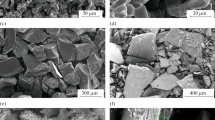Abstract—
TiC + xC composites comprising titanium carbide particles, unreacted carbon black particles, and a graphite nanofilm have been prepared by self-propagating high-temperature synthesis pressing. The fused titanium carbide particles form a robust skeleton, whose voids contain carbon black particles separated from the titanium carbide particles by the graphite nanofilm. We have examined the effect of composition and temperature on the resistivity of the TiC + xC composites. The resistivity of the composites has been shown to increase with increasing carbon content. In the temperature range 300–1300 K, the temperature coefficient of resistivity (TCR) of the TiC + 0.25C, TiC + 0.5C, and TiC + 0.75C composites is 8.9 × 10–4, 9.5 × 10–4, and 9.7 × 10–4 K–1, respectively. In the temperature range 1000–1010 K, the resistivity of the composites remains constant as a result of the ordering of the carbon sublattice in TiC.



Similar content being viewed by others
REFERENCES
Kiparisov, S.S., Levinskii, Yu.V., and Petrov, A.P., Karbid titana: poluchenie, svoistva, primenenie (Titanium Carbide: Preparation, Properties, and Applications), Moscow: Metallurgiya, 1987.
Gusev, A.I., Disorder and long-range ordering non-stoichiometric interstitial compounds transition metal carbides, nitrides, and oxides, Phys. Status Solidi B, 1991, vol. 163, no. 1, pp. 17–54.https://doi.org/10.1002/pssb.2221630102
Lipatnikov, V.N., Kottar, A., Zueva, L.V., and Gusev, A.I., Order–disorder phase transformations and electrical resistance of nonstoichiometric titanium carbide, Fiz. Tverd. Tela (S.-Peterburg), 1998, vol. 40, no. 7, pp. 1332–1340.
Zueva, L.V. and Gusev, A.I., Effect of nonstoichiometry and ordering on the basic structure period of cubic titanium carbide, Fiz. Tverd. Tela (S.-Peterburg), 1999, vol. 41, no. 7, pp. 1134–1141.
Prokudina, V.K., Ratnikov, V.I., Maslov, V.M., Borovinskaya, I.P., Merzhanov, A.G., and Dubovitskii, F.I., Titanium carbides production technology, in Protsessy goreniya v khimicheskoi tekhnologii i metallurgii (Combustion Processes in Chemical Technology and Metallurgy), Chernogolovka, 1975, pp. 136–141.
Merzhanov, A.G., Rogachev, A.S., Mukas’yan, A.S., and Khusid, B.M., Macrokinetics of structural transformations during gas-free combustion of titanium–carbon powder mixtures, Fiz. Goreniya Vzryva, 1990, no. 1, pp. 104–114.
Advani, A.H., Thadhani, N.N., and Grebe, H.A., Dynamic modeling of material and process effects on self-propagating high-temperature synthesis of titanium carbide ceramics, J. Mater. Sci., 1992, vol. 27, no. 12, pp. 3309–3317.https://doi.org/10.1007/BF01116030
Kobashi, M., Ichioka, D., and Kanetake, N., Combustion synthesis of porous TiC/Ti composite by a self-propagating mode, Materials, 2010, vol. 3, pp. 3939–3947.https://doi.org/10.3390/ma3073939
Emel’yanov, A.N., Order–disorder phase transition of nonstoichiometric transition metal carbides, Fiz. Tverd. Tela (S.-Peterburg), 1996, no. 12, pp. 3678–3682.
Karpov, A.V. and Kobyakov, V.P., Order–disorder phase transition of TiC0.55, Neorg. Mater., 1995, vol. 31, no. 5, pp. 655–659.
El-Eskandarany, M.S., Synthesis of nanocrystalline titanium carbide alloy powders by mechanical solid-state reaction, Metall. Mater. Trans. A, 1996, vol. 27, pp. 2374–2382.
Pityulin, A.N., Force compaction in SHS processes, in Samorasprostranyayushchiisya vysokotemperaturnyi sintez: teoriya i praktika (Self-Propagating High-Temperature Synthesis: Theory and Practice), Sychev, A.E., Ed., Chernogolovka: Territoriya, 2001, pp. 333–353.
Karpov, A.V., Morozov, Yu.G., Bunin, V.A., and Borovinskaya, I.P., Effect of yttria additions on the electrical conductivity of SHS nitride ceramics, Inorg. Mater., 2002, vol. 38, no. 6, pp. 631–634.
Gorinskii, S.G., Shabalin, I.L., Beketov, A.R., and Kokorin, A.F., Electrical conductivity of carbide–carbon materials, Izv. Akad. Nauk SSSR,Neorg. Mater., 1979, vol. 15, no. 10, pp. 1769–1774.
Author information
Authors and Affiliations
Corresponding author
Additional information
Translated by O. Tsarev
Rights and permissions
About this article
Cite this article
Shcherbakov, V.A., Gryadunov, A.N., Karpov, A.V. et al. Self-Propagating High-Temperature Synthesis of TiC + xC Composites. Inorg Mater 56, 567–571 (2020). https://doi.org/10.1134/S0020168520060102
Received:
Revised:
Accepted:
Published:
Issue Date:
DOI: https://doi.org/10.1134/S0020168520060102




